Chemical Oxidative Polymerization of 2-Aminothiazole in Aqueous Solution: Synthesis, Characterization and Kinetics Study
Abstract
:1. Introduction
2. Materials and Methods
2.1. Materials
2.2. Synthesis of PAT
2.3. Kinetics Studies
2.4. Characterization
3. Results and Discussion
3.1. Optimization of the Polymerization Conditions
3.2. Structure and Morphology
3.3. Thermal Stability
3.4. Electrical Conductivity
3.5. Kinetics of Polymerization
3.5.1. Effect of Monomer Concentration
3.5.2. Effect of the Oxidant Concentration
3.5.3. Calculation of the Thermodynamic Parameters
4. Conclusions
Supplementary Materials
Acknowledgments
Author Contributions
Conflicts of Interest
References
- Chen, S.; Lu, B.Y.; Duan, X.M.; Xu, J.K. Systematic study on chemical oxidative and solid-state polymerization of poly(3,4-ethylenedithiathiophene). J. Polym. Sci. Part A 2012, 50, 1967–1978. [Google Scholar] [CrossRef]
- Roldan, P.S.; Alcântara, I.L.; Rocha, J.C.; Padilha, C.F.; Padilha, P.M. Determination of copper, iron, nickel and zinc in fuel kerosene by FAAS after adsorption and pre-concentration on 2-aminothiazolemodified silica gel. Eclética Química 2004, 29, 33–40. [Google Scholar] [CrossRef]
- Roldan, P.S.; Alcântara, I.L.; Castro, G.R.; Rocha, J.C.; Padilha, C.F.; Padilha, P.M. Determination of Cu, Ni, and Zn in fuel ethanol by FAAS after enrichment in column packed with 2-aminothiazolemodified silica gel. Anal. Bioanal. Chem. 2003, 375, 574–577. [Google Scholar] [CrossRef] [PubMed]
- Alcântara, I.L.; Roldan, P.S.; Margionte, M.A.L.; Castro, G.R.; Padilha, C.F.; Florentino, A.O.; Padilha, P.M. Determination of Cu, Ni and Pb in aqueous medium by FAAS after preconcentration on 2-aminothiazole modified silica gel. J. Braz. Chem. Soc. 2004, 15, 366–371. [Google Scholar] [CrossRef]
- Alcântara, I.L.; Roldan, P.S.; Castro, G.R. Determination of cadmium in river water samples by flame AAS after on-line preconcentration in mini-column packed with 2-aminothiazole-modified silica gel. Anal. Sci. 2004, 27, 1029–1032. [Google Scholar] [CrossRef]
- Valtair, M.C.; Araujo, A.B.; Sônia, M.A.; Ariovaldo, O.F.; Valente, J.P.S.; Pedro, M. Enhanced photocatalytic reduction of Hg(II) in aqueous medium by 2-aminothiazole-modified TiO2 particles. J. Braz. Chem. Soc. 2006, 17, 453–457. [Google Scholar]
- Xiong, C.H.; Jia, Q.; Chen, X.Y.; Wang, G.T.; Yao, C.P. Optimization of polyacrylonitrile-2-aminothiazole resin synthesis, characterization, and its adsorption performance and mechanism for removal of Hg(II) from aqueous solutions. Ind. Eng. Chem. Res. 2013, 52, 4978–4986. [Google Scholar] [CrossRef]
- Xiong, C.H.; Zhou, S.G.; Liu, X.Z.; Jia, Q.; Ma, C.N.; Zheng, X.M. 2-Aminothiazole functionalized polystyrene for selective removal of Au(III) in aqueous solutions. Ind. Eng. Chem. Res. 2014, 53, 2441–2448. [Google Scholar] [CrossRef]
- Shan, C.; Ma, Z.Y.; Tong, M.P.; Ni, J.R. Removal of Hg (II) by poly(1-vinylimidazole)-grafted Fe3O4@SiO2 magnetic nanoparticles. Water Res. 2015, 69, 252–260. [Google Scholar] [CrossRef] [PubMed]
- Çiftçi, H.; Öktem, Z. Voltammetric determination of Hg(II) at poly(2-aminothiazole) modified platinum electrode. Fresen. Environ. Bull. 2011, 20, 924–928. [Google Scholar]
- Dubrovskii, R.A.; Aksiment’eva, E.A. Anodic synthesis and properties of polyaminothiazole. Russ. J. Electrochem. 2008, 44, 234–237. [Google Scholar] [CrossRef]
- Solmaz, R.; Kardaş, G. Electrochemical synthesis and characterization of poly-2-aminothiazole. Prog. Org. Coat. 2009, 64, 81–88. [Google Scholar] [CrossRef]
- Solmaz, R. Electrochemical synthesis of poly-2-aminothiazole on mild steel and its corrosion inhibition performance. Prog. Org. Coat. 2011, 70, 122–126. [Google Scholar] [CrossRef]
- Solmaz, R.; Şahin, E.A.; Kardaş, G. Electrochemical preparation and characterization of nickel and zinc-modified poly-2-aminothiazole films on mild steel surface and their corrosion inhibition performance. React. Funct. Polym. 2011, 71, 1148–1154. [Google Scholar] [CrossRef]
- Çiftçi, H.; Testereci, H.N.; Öktem, Z. Electrochemical polymerization of 2-aminothiazole. Polym. Bull. 2010, 66, 747–760. [Google Scholar] [CrossRef]
- Yildirim, M.; Kaya, I. A comparative study of aminothiazole-based polymers synthesized by chemical oxidative polymerization. Synth. Met. 2012, 162, 436–443. [Google Scholar] [CrossRef]
- Nabid, M.R.; Bide, Y. Morphological investigation of poly(2-aminothiazole) prepared by rapid initiated polymerization. Adv. Polym. Technol. 2016. [Google Scholar] [CrossRef]
- Ciftci, H.; Testereci, H.N.; Öktem, Z. Ring opening polymerization of 2-aminothiazole with iron(III) chloride. Polym. Bull. 2013, 70, 1895–1909. [Google Scholar] [CrossRef]
- Biyikoglu, M.; Ciftci, H. Chemical synthesis and characterization of soluble conducting poly(2-aminothiazole). Polym. Bull. 2013, 70, 2843–2856. [Google Scholar] [CrossRef]
- Wang, X.; Wang, L.; Zou, H.; Qian, W.; Liao, Y.Z. Simple synthesis of conducting poly(2-aminothiazole) with high molecular weight. Colloid Polym. Sci. 2015, 293, 2027–2034. [Google Scholar] [CrossRef]
- Wang, X.; Lv, P.F.; Zou, H.; Li, Y.; Li, X.Y.; Liao, Y.Z. Synthesis of poly(2-aminothiazole) for selective removal of Hg(II) in aqueous solutions. Ind. Eng. Chem. Res. 2016, 55, 4911–4918. [Google Scholar] [CrossRef]
- Tzou, K.; Gregory, R.V. Kinetic study of the chemical polymerization of aniline in aqueous solutions. Synth. Met. 1992, 47, 267–277. [Google Scholar] [CrossRef]
- Fu, Y.P.; Elsenbaumer, R.L. Thermochemistry and kinetics of chemical polymerization of aniline determined by solution calorimetry. Chem. Mater. 1994, 6, 671–677. [Google Scholar] [CrossRef]
- Gill, M.T.; Chapman, S.E.; DeArmitt, C.L.; Baines, F.L.; Dadswell, C.M.; Stamper, J.G.; Lawless, G.A.; Billingham, N.C.; Armes, S.P. A study of the kinetics of polymerization of aniline using proton NMR spectroscopy. Synth. Met. 1998, 93, 227–233. [Google Scholar] [CrossRef]
- Chakraborty, M.; Mukherjee, D.C.; Mandal, B.M. Dispersion polymerization of aniline in different media: A UV-visible spectroscopic and kinetic study. Langmuir 2000, 16, 2482–2488. [Google Scholar] [CrossRef]
- Minami, H.; Okubo, M.; Murakami, K.; Hirano, S. Kinetics of chemical oxidative dispersion polymerization of 3,5-xylidine in aqueous medium using a PH stat method. J. Polym. Sci. Part A 2000, 38, 4238–4246. [Google Scholar] [CrossRef]
- Sivakumar, C.; Gopalan, A.; Vasudevan, T.; Wen, T.C. Kinetics of polymerization of N-methyl aniline using UV–VIS spectroscopy. Synth. Met. 2002, 126, 123–135. [Google Scholar] [CrossRef]
- Tan, Y.; Ghandi, K. Kinetics and mechanism of pyrrole chemical polymerization. Synth. Met. 2013, 175, 183–191. [Google Scholar] [CrossRef]
- Sayyah, S.M.; Khaliel, A.B.; Aboud, A.A.; Mohamed, S.M. Chemical polymerization kinetics of poly-o-phenylenediamine and characterization of the obtained polymer in aqueous hydrochloric acid solution using K2Cr2O7 as oxidizing agent. Int. J. Polym. Sci. 2014. [Google Scholar] [CrossRef]
- Stejskal, J.; Sapurina, I.; Trchova, M. Polyaniline nanostructures and the role of aniline oligomers in their formation. Prog. Polym. Sci. 2010, 35, 1420–1481. [Google Scholar] [CrossRef]
- Kopecká, J.; Kopecký, D.; Vrňata, M.; Fitl, P.; Stejskal, J.; Trchová, M.; Bober, P.; Morávková, Z.; Prokeš, J.; Sapurina, I. Polypyrrole nanotubes: Mechanism of formation. RSC Adv. 2014, 4, 1551–1558. [Google Scholar] [CrossRef]
- Leonavicius, K.; Ramanaviciene, A.; Ramanavicius, A. Polymerization model for hydrogen peroxide initiated synthesis of polypyrrole nanoparticles. Langmuir 2011, 27, 10970–10976. [Google Scholar] [CrossRef] [PubMed]

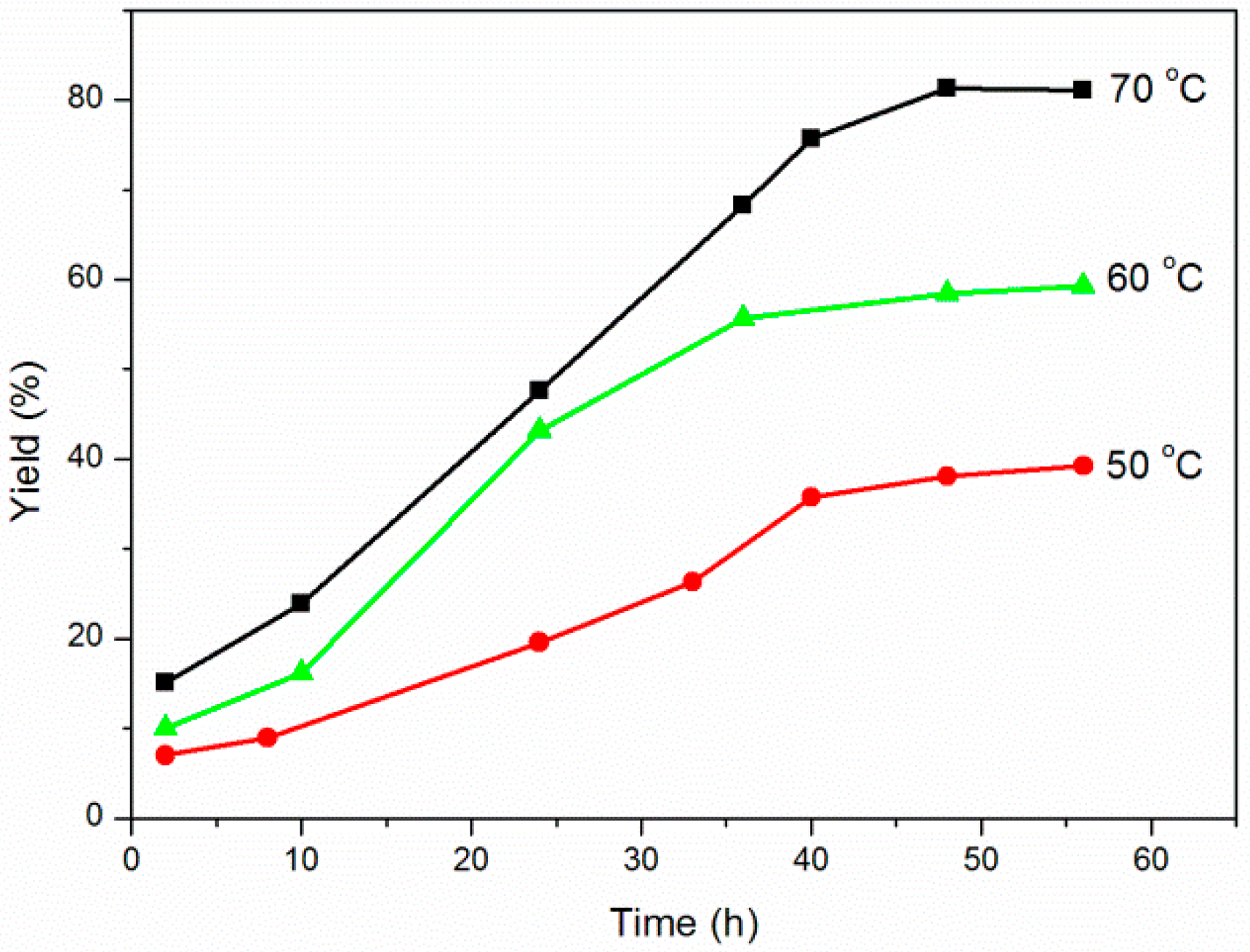
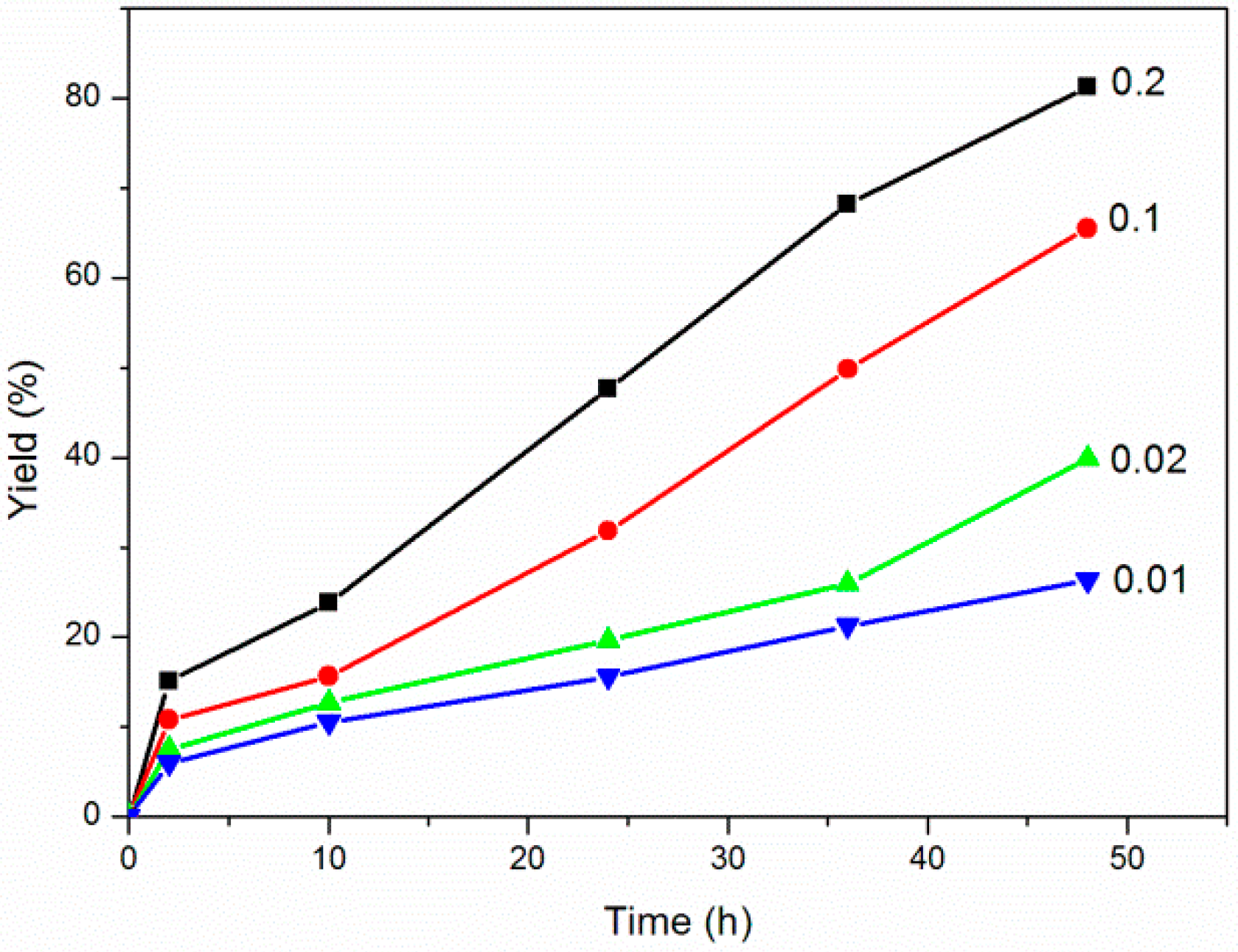
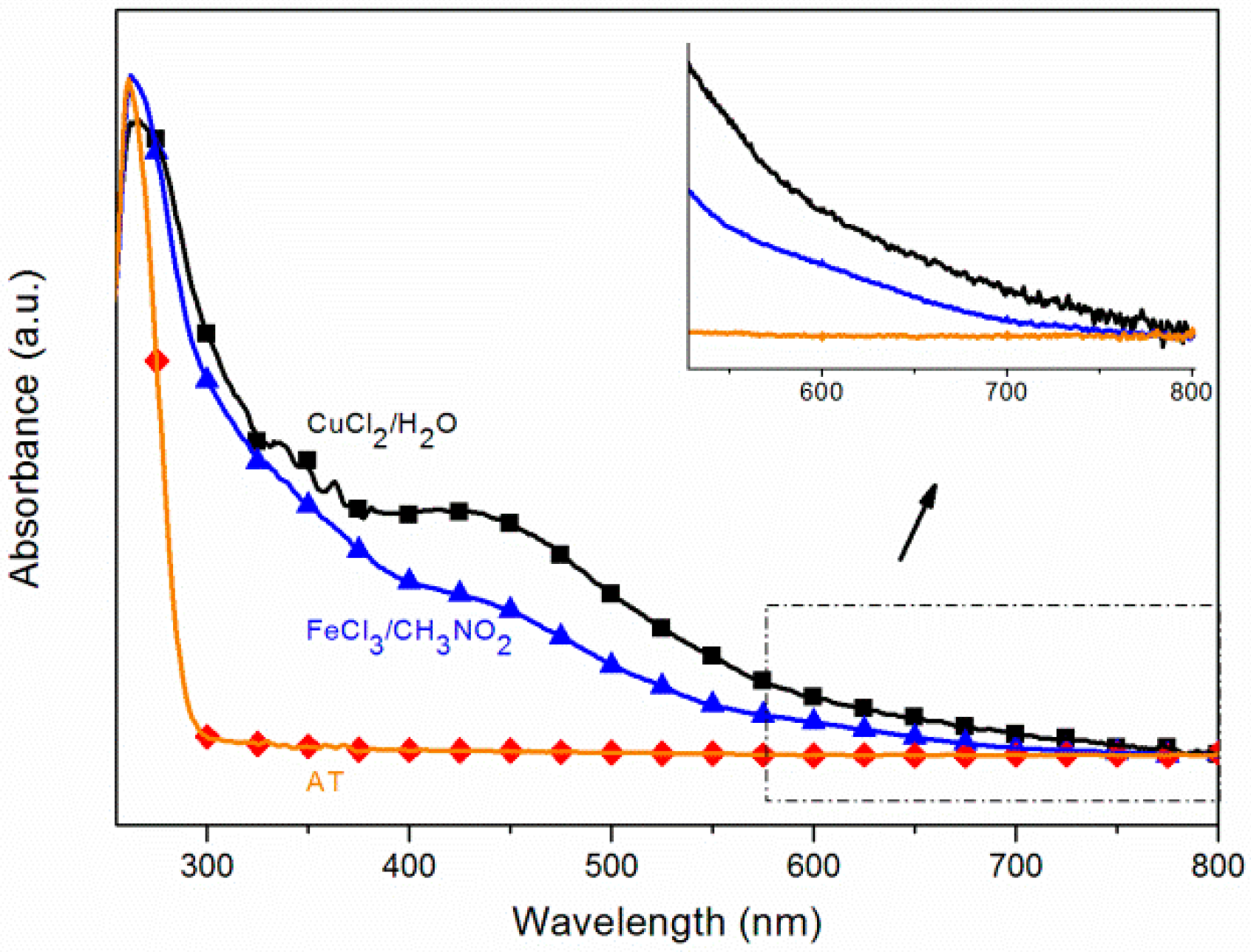
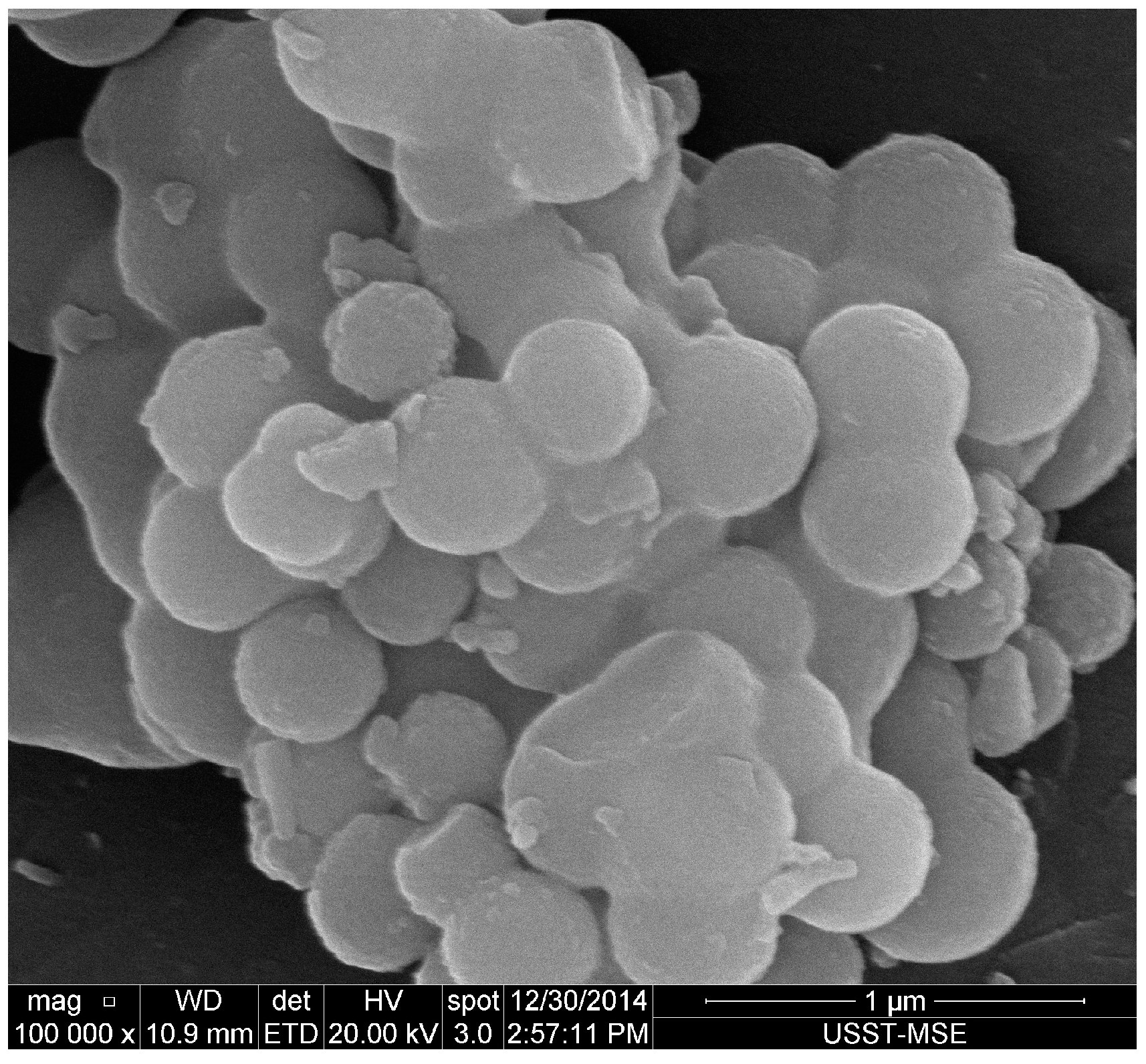
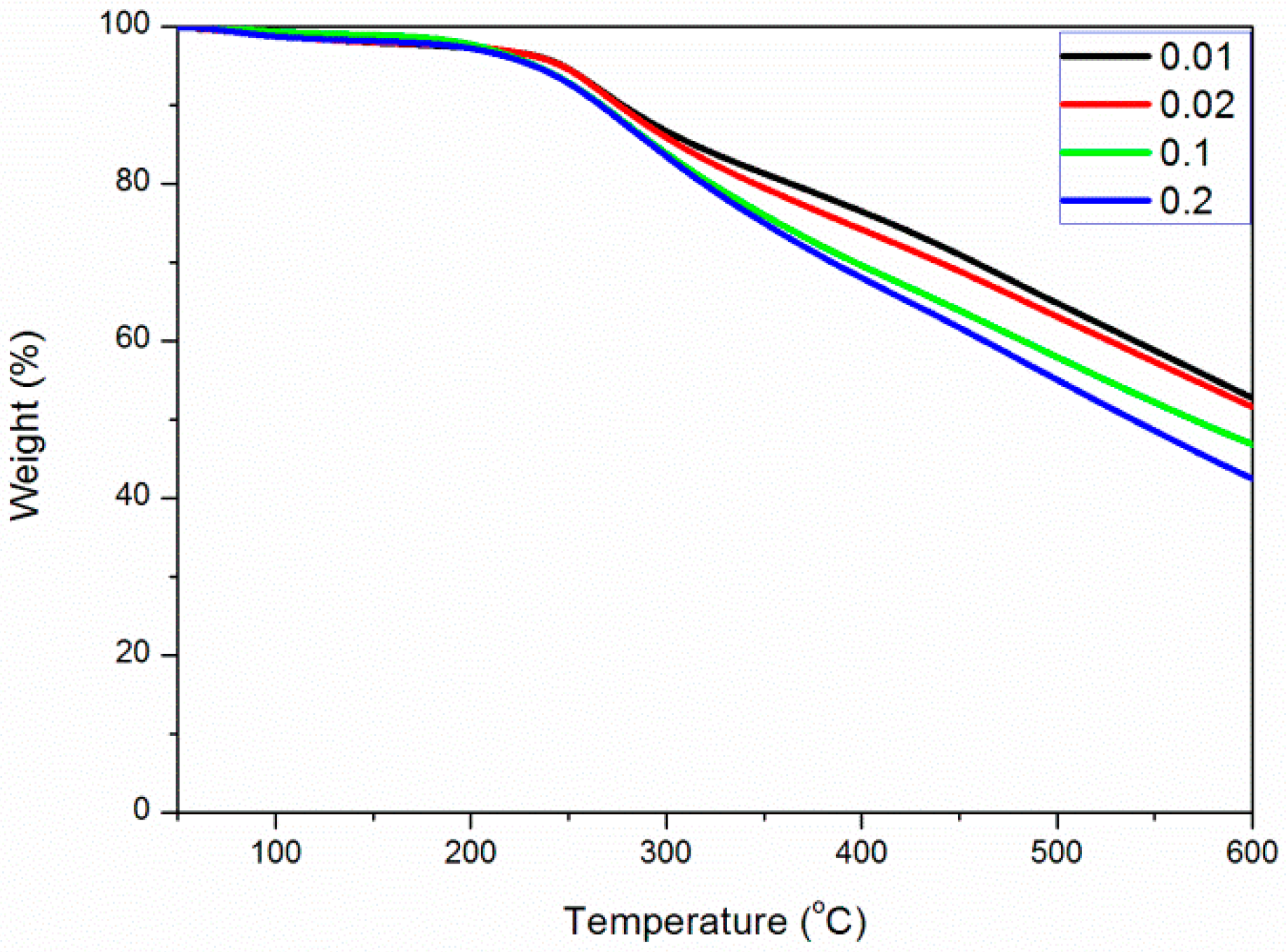
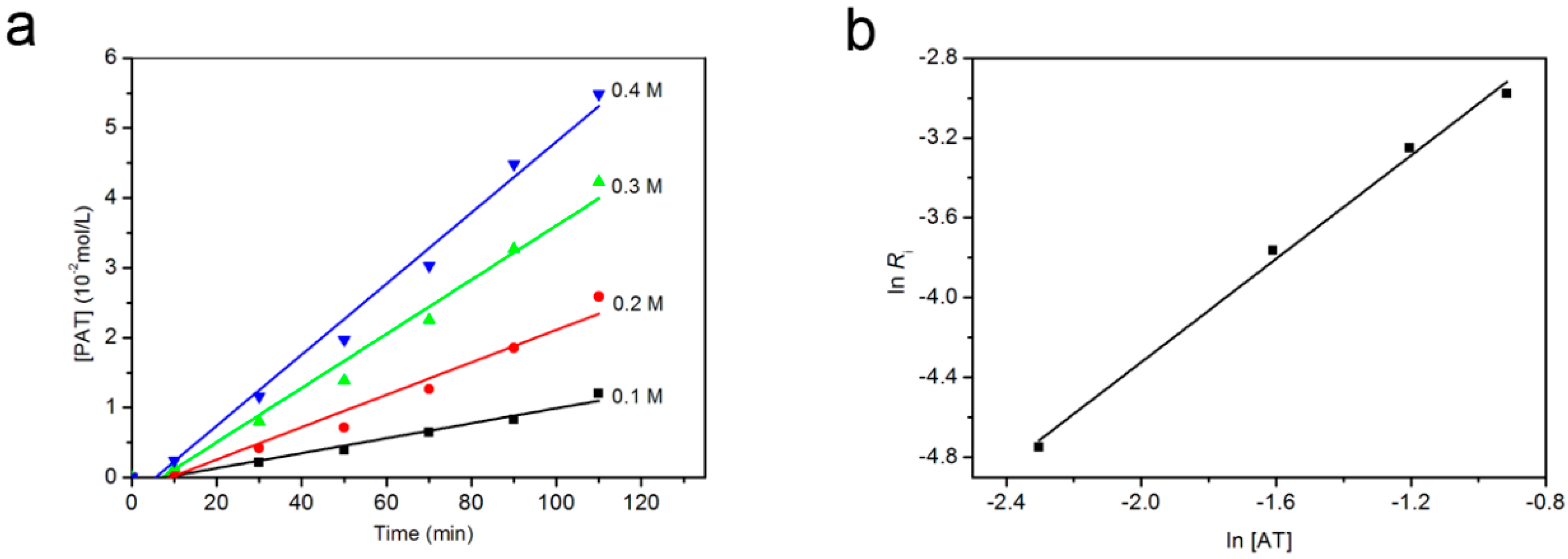
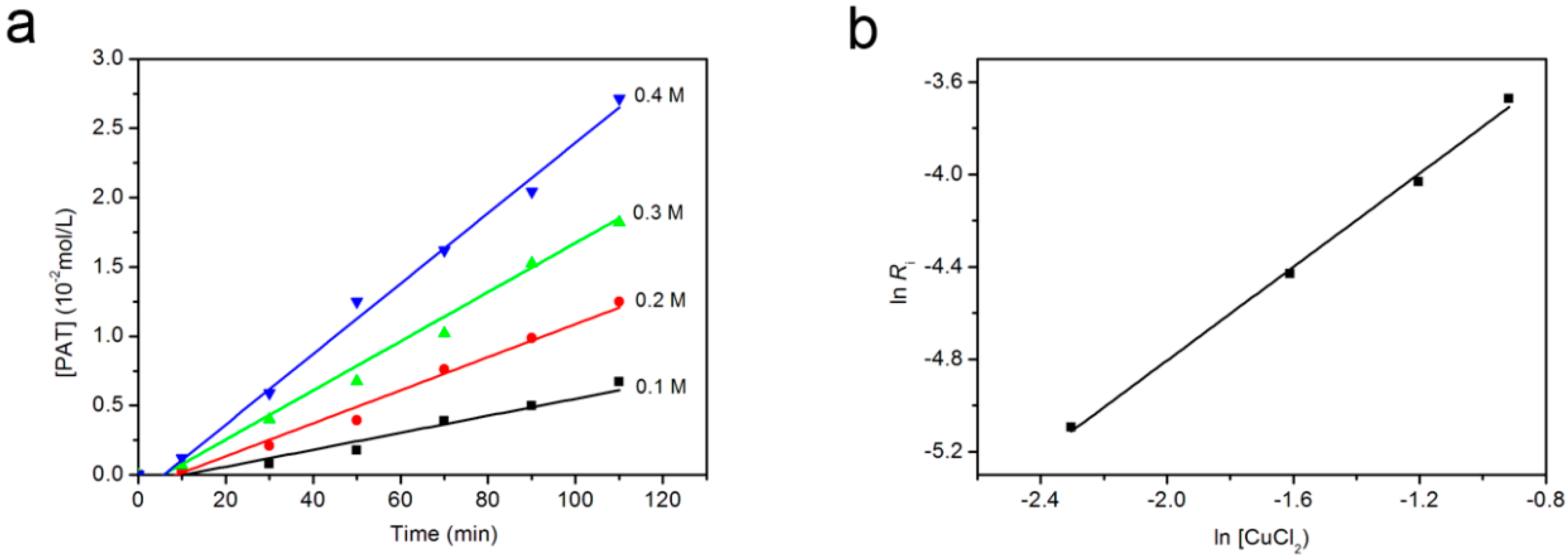
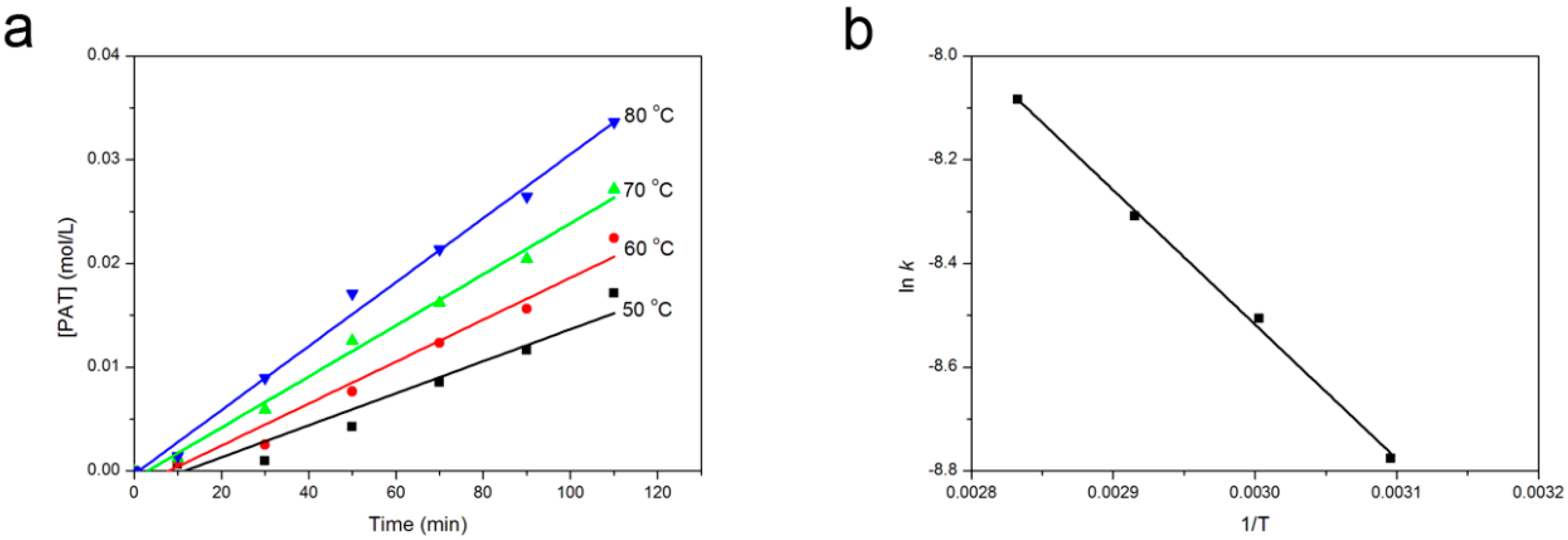
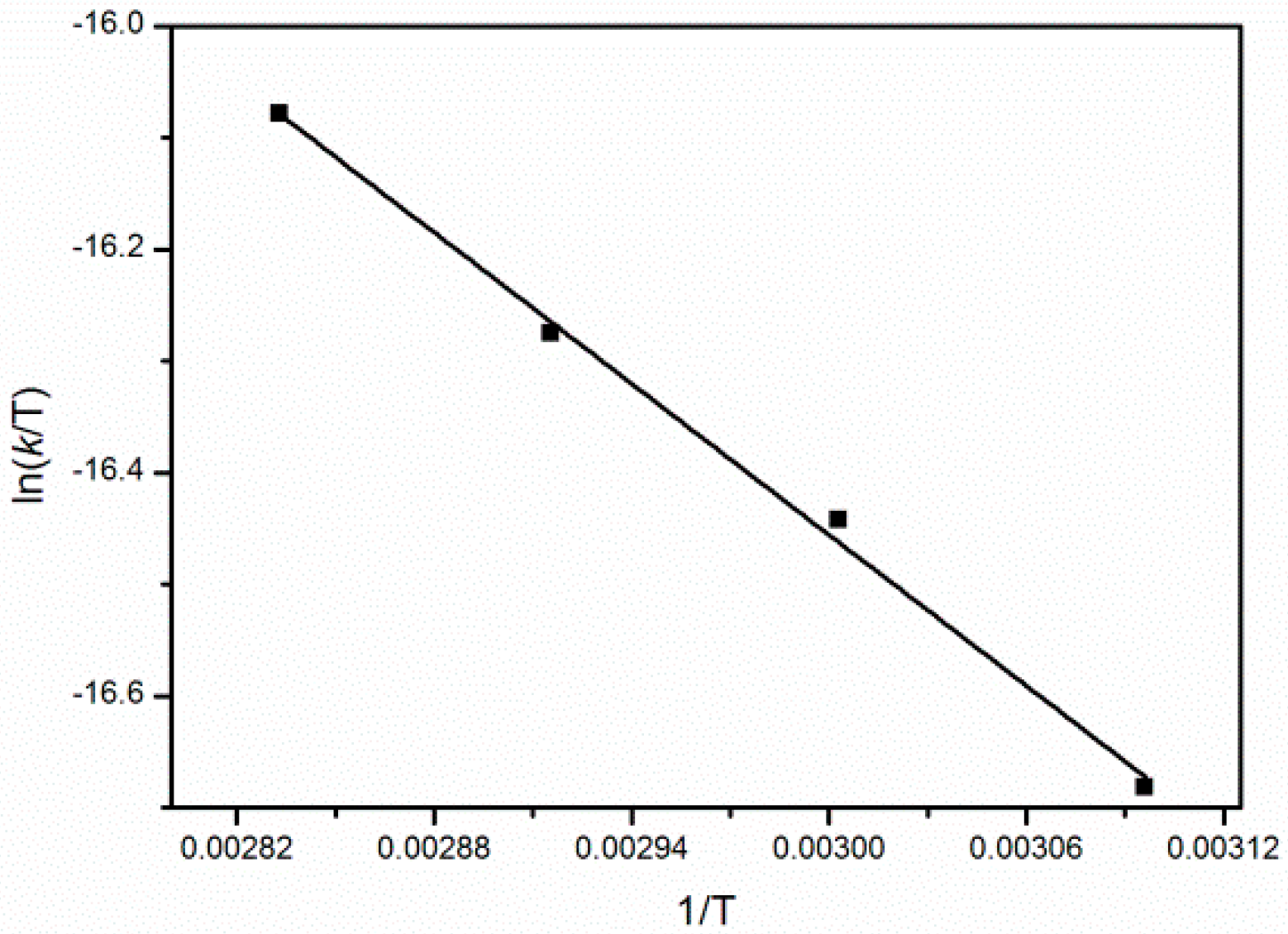
| Oxidant/Monomer molar ratio | CuCl2/H2O (°C) | FeCl3/CH3NO2 (°C) [20] |
|---|---|---|
| 0.2 | 220 | 135 |
| 0.1 | 224 | 165 |
| 0.02 | 236 | 183 |
| 0.01 | 240 | 210 |
| Oxidant/Monomer molar ratio | Original (S/cm) | 12 h (S/cm) | 24 h (S/cm) |
|---|---|---|---|
| 0.2 | 1.0 × 10−14 | 1.0 × 10−7 | 1.3 × 10−5 |
| 0.1 | 5.0 × 10−14 | 3.6 × 10−7 | 3.9 × 10−5 |
| 0.02 | 3.0 × 10−14 | 9.0 × 10−7 | 1.7 × 10−4 |
| 0.01 | 1.0 × 10−13 | 4.0 × 10−6 | 2.1 × 10−4 |
© 2016 by the authors. Licensee MDPI, Basel, Switzerland. This article is an open access article distributed under the terms and conditions of the Creative Commons Attribution (CC-BY) license ( http://creativecommons.org/licenses/by/4.0/).
Share and Cite
Zou, H.; Wang, L.; Wang, X.; Lv, P.; Liao, Y. Chemical Oxidative Polymerization of 2-Aminothiazole in Aqueous Solution: Synthesis, Characterization and Kinetics Study. Polymers 2016, 8, 407. https://doi.org/10.3390/polym8110407
Zou H, Wang L, Wang X, Lv P, Liao Y. Chemical Oxidative Polymerization of 2-Aminothiazole in Aqueous Solution: Synthesis, Characterization and Kinetics Study. Polymers. 2016; 8(11):407. https://doi.org/10.3390/polym8110407
Chicago/Turabian StyleZou, Hua, Lu Wang, Xia Wang, Pengfei Lv, and Yaozu Liao. 2016. "Chemical Oxidative Polymerization of 2-Aminothiazole in Aqueous Solution: Synthesis, Characterization and Kinetics Study" Polymers 8, no. 11: 407. https://doi.org/10.3390/polym8110407







